Pink Pearls
This is not the case with coralberry. When its leaves drop, a glowing display of pink pearls appears. These pearls are swelling and blushing now. Magnificent!
Coralberry (Symphoricarpos sp.) is a spreading groundcover native to North America. It is often seen growing on sloping sites with poor soils. The "almost weedy" plant is easy to grow and tolerates drought, alkaline soil and deer.
The introduction of cultivars with more upright and compact habits has made this adaptable plant a new and showy addition to home landscapes. These cultivars include Proven Winners Proud Berry®, and First Editions® Candy™ and Sweet™.
Place coralberry in a sunny spot to maximize fruit production and minimize leaf diseases. Trim the shrub back to 12 inches every spring. The new growth will develop tiny, bell-shaped flowers in summer and amazing pink pearls in fall. The pearl-laden branches make wonderful cut flower displays over the holidays!
The fruits are mildly toxic and should not be eaten. They contain saponin, the same toxin found in Digitalis (foxglove).
Perhaps this toxin contributes to the persistence of the fruit. Birds stay away from the berries until late in winter, allowing us to enjoy the beauty of the fruits for months. The berries look lovely when speckled with snow.
If you are looking for a unique plant that stands out in winter landscapes and in holiday bouquets, consider growing one of the new and improved cultivars of coralberry.
Written by Tom Kalb, Extension Horticulturist, North Dakota State University. Published in the NDSU Yard & Garden Report for October 7, 2017.
Sources: Bailey Nurseries, Inc.; Grant, A., Coralberry shrub information; and Proven Winners. Photos were made available under Creative Commons licenses specified by the photographers: Bailey Nurseries, Inc. and Proven Winners.


